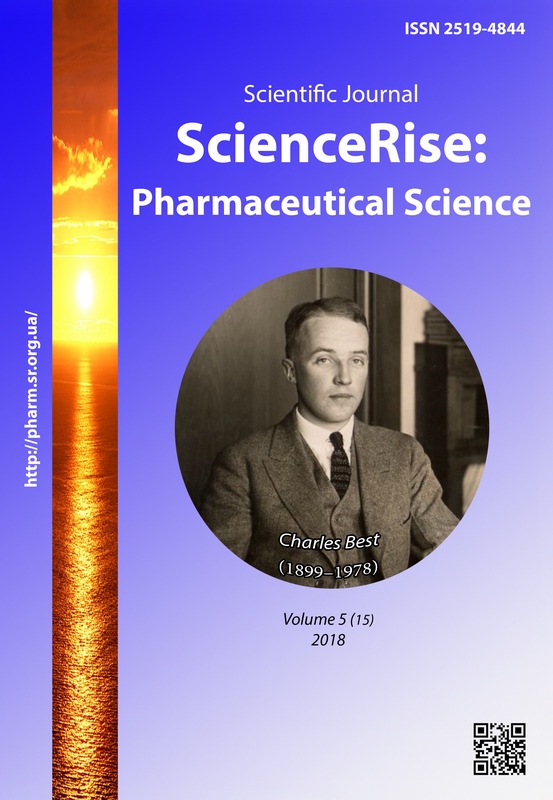Analysis of psychotropic medicines triazolam, estazolam and alprazolam mixture using high-performance liquid chromatography method
DOI:
https://doi.org/10.15587/2519-4852.2018.146364Keywords:
triazolam, estazolam, alprazolam, high-performance liquid chromatography, qualitative and quantitative determinationAbstract
Poisoning of benzodiazepines, particularly triazolam, estazolam and alprazolam usually is caused by consumption of the drug in bigger doses than prescribed. So, for the fast determination of material caused poisoning, selective and effective methods of analysis are requested.
Methods. Benzodiazepines triazolam, estazolam and alprazolam, were chosen for investigation. Analysis was performed using chromatograph „Waters 2695” with a photodiode array detector (Waters 996, at wavelength 200-400 nm range), ACE C18 (2,1 mm x 5,0 cm, 5 μm) chromatographic column, gradient eluent flow (sulfuric acid buffer 0,1% and ACN), eluent flow rate 0,1 ml/min and injection volume of 10 µl.
Results. Methodics for identification and quantification of triazolam, estazolam, alprazolam and their mixture was developed using reference solutions. Validated methodic was adapted for identification and quantification of triazolam, estazolam, alprazolam in medicinal products.
Conclusions. Selected methodic is suitable for qualification and quantification of the medicinal preparations: ACE C18 (2,1 mm x 5,0 cm, 5 μm) chromatographic column, gradient eluent flow (sulfuric acid buffer 0,1% and ACN), eluent flow rate 0,1 ml/min, injection volume of 10 µl and diode array detector. Mixture of components has been examined and retention times have been stated as follows: alprazolam (13,216 min), estazolam (13,407 min) and triazolam (14,340 min). Retention time upon repetition of analysis have not exceeded the relative error of p <0,05 limitation.
Limits of detection of alprazolam is 0,01 µg/ml, estazolam 0,012 µg/ml, triazolam 0,020 µg/ml. Limit of quantification of alprazolam is 0, 022 µg/ml, estazolam 0, 025 µg/ml, triazolam 0, 045 µg/ml
References
- Medicines consumption in Lithuania (2017). Available at: http://www.vvkt.lt/Front-Page
- Hobelmann, J. G., Clark, M. R.; Staats, P., Silverman, S. (Eds.) (2016). Benzodiazepines, Alcohol, and Stimulant Use in Combination with Opioid Use. Controlled Substance Management in Chronic Pain. Cham: Springer, 75–86. doi: http://doi.org/10.1007/978-3-319-30964-4_6
- Galanter, M., Kleber, H. D., Brady, K. T. (Eds.) (2014). The American Psychiatric Publishing Textbook of Substance Abuse Treatment. Washington: American Psychiatric Publishing. doi: http://doi.org/10.1176/appi.books.9781615370030
- Harvey, R. A., Champe, P. C., Finkel, R., Cubeddu, L. X., Clark, M. A. (Eds.) (2009). Lippincott Illustrated Reviews: Pharmacology. Lippincott Williams & Wilkins, 564.
- Tsutaoka, B., Olson, K. R. (2012). Chapter 31. Benzodiazepines. Poisoning & Drug Overdose. McGraw-Hill, Available at: https://mhmedical.com/Content.aspx?bookId=391§ionId=42069845
- Fernández, P., González, C., Pena, M. T., Carro, A. M., Lorenzo, R. A. (2013). A rapid ultrasound-assisted dispersive liquid–liquid microextraction followed by ultra-performance liquid chromatography for the simultaneous determination of seven benzodiazepines in human plasma samples. Analytica Chimica Acta, 767, 88–96. doi: http://doi.org/10.1016/j.aca.2013.01.016
- Mistry, K., Grinberg, N. (2005). Application of Monolithic Columns in High Performance Liquid Chromatography. Journal of Liquid Chromatography & Related Technologies, 28 (7-8), 1055–1074. doi: http://doi.org/10.1081/jlc-200052972
- Moffat, A. C., Osselton, M. D., Widdop, B. (2011). Clarke‘s Analysis of Drugs and Poisons. London: Pharmaceutical Press, 2473.
- Japp, M., Garthwaite, K., Geeson, A. V., Osselton, M. D. (1988). Collection of analytical data for benzodiazepines and benzophenones. Journal of Chromatography A, 439 (2), 317–339. doi: http://doi.org/10.1016/s0021-9673(01)83844-9
- Mura, P., Piriou, A., Fraillon, P., Papet, Y., Reiss, D. (1987). Screening procedure for benzodiazepines in biological fluids by high-performance liquid chromatography using a rapid-scanning multichannel detector. Journal of Chromatography B: Biomedical Sciences and Applications, 416, 303–310. doi: http://doi.org/10.1016/0378-4347(87)80513-3
- Theis, D. L., Bowman, P. B. (1983). Development of a liquid chromatographic method for the determination of triazolo-benzodiazepines. Journal of Chromatography A, 268, 92–98. doi: http://doi.org/10.1016/s0021-9673(01)95391-9
- Flanagan, R. J., Storey, G. C. A., Bhamra, R. K., Jane, I. (1982). High performance liquid chromatographic analysis of basic drugs on silica columns using non-aqueous ionic eluents. Journal of Chromatography A, 247 (1), 15–37. doi: http://doi.org/10.1016/s0021-9673(00)84853-0
- Chiarotti, M., De Giovanni, N., Fiori, A. (1986). Analysis of benzodiazepines: I. Chromatographic identification. Journal of Chromatography A, 358, 169–178. doi: http://doi.org/10.1016/s0021-9673(01)90326-7
Downloads
Published
How to Cite
Issue
Section
License
Copyright (c) 2018 Yelyzaveta Kravchuk, Mindaugas Marksa, Augusta Zevzikoviene, Andrejus Zevzikovas

This work is licensed under a Creative Commons Attribution 4.0 International License.
Our journal abides by the Creative Commons CC BY copyright rights and permissions for open access journals.








